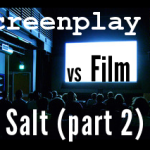Weak stories.
No one intends to write one.
And yet, so many screenplays and novels are too flimsy to attract buyers.
How does this happen?
Their central protagonist lacks a clear, strong goal. A storytelling essential, it:
- provides the backbone of your story
- determines who the antagonist is
- defines the stakes
If your protagonist doesn’t have a goal, it’s virtually impossible to write a page-turner. Simple as that.
Most writers realize this. The problem is, they forget it.
Seduced by an intriguing character, theme, or setting, they lose sight of the fact that their story has no narrative drive.
Save yourself a lot of trouble. Make sure your protagonist has a clear goal before you start writing.
However, any old goal will not do. As Vesper Lynd says in CASINO ROYALE, “there are dinner jackets and dinner jackets.”
Like Bond, you want to rock the latter. This is where thinking like a project manager comes into play.
Project managers routinely define the objectives of their team using a SMART framework. Each letter of the acronym stands for a feature which, having been established, makes it much easier for the team to accomplish their goals.
Happily, this approach also has a practical—and valuable—application for writers. The “SMARTer” you make your protagonist’s goal, the stronger your story will be as a whole…
…and the less likely it will sink when launched into open waters.
So, what are the characteristics of SMART goals? They are:
- S – Specific
- M – Measurable
- A – Actionable (and adaptable)
- R – Realistic
- T – Time-bound
Note: Depending on context, each letter can take on a different attribute; here’s a full list, courtesy of Wikipedia. I’m focusing on the 5 features that are most relevant to you, as a storyteller.
Let’s take a closer look at each one, shall we?
S – Specific
Your protagonist’s goal needs to be specific and concrete, not vague or abstract.
If your protagonist’s goal is too amorphous, theme can easily overtake your plot, resulting in a slow-paced, aimless story which is unlikely to satisfy fans of your genre.
Out of all of the elements within the SMART framework, this one is the most important. Usually, if your protagonist’s goal is specific enough, then everything else will naturally fall into place.
For example, you might want to write a story about a hero who redeems himself. While worthy and admirable, this goal isn’t specific enough.
It’s too abstract.
You need to specifically define how your hero is going to redeem himself, as in IN THE LINE OF FIRE. A Secret Service agent redeems himself for failing to protect JFK in the past by saving the life of the president in the present.
See the difference?
In contrast to redemption, saving the life of the president is a goal which audiences can see and immediately understand.
Actually, if you’re writing an action movie, mystery, or thriller, it might be constructive to start by brainstorming from the point of view of the bad guy.
What does he want to do? Again, be specific.
After that, simply reverse engineer your protagonist’s goal. He must stop the villain from bringing about whatever calamity you’ve defined using the SMART framework.
M – Measurable
In the world of project management, this means that your goal is quantifiable. In the world of storytelling, this is rarely the case.
Off the top of my head, I can think of only one climax that could be categorized as quantifiable (at least in part): ERIN BROCKOVICH.
After the town meeting, Erin and Ed need to get 150 more Hinkley residents to sign agreements consenting to binding arbitration. We’ll know that Erin and Ed have been successful once they’ve gathered all of these signatures.
For most screenplays or novels, you won’t be able to reduce your story climax to a number. Even so, there should be a clear indicator that your protagonist has succeeded or failed. That’s how it will be measurable.
If your goal lacks this indicator, it’s a good sign that it’s not specific enough.
This is often a major failing in character-driven stories like SILVER LININGS PLAYBOOK. This movie could have easily gone so wrong.
So, so wrong.
Fair warning: this explanation is a bit lengthy. If you’re not writing a story in this vein, you might want to skip ahead to the next letter, “A.”
At the beginning of the film, there’s this scene where Pat throws a copy of A Farewell to Arms out of the window because he’s so disgusted by the ending.
As a side note, endings tend to evoke strong emotions from audiences, which is why it’s so important to pick the right ending for your story. But I digress.
Back to Pat and SILVER LININGS. After throwing the book out the window, Pat wakes up his beleaguered parents to rant about it.
This is killer stuff.
The tossing of the Hemingway classic perfectly illuminates Pat’s character with one beat of action.
One beat.
Ten years from now, I will have probably forgotten Pat’s name, but I will remember that moment.
It’s great writing. Fantastic. And this is where many writers would make a fatal mistake.
They’d think that filling their screenplay with fascinating insights into the human psyche is enough.
Sure, these insights will probably be enough to attract top talent. This, in turn, can be enough to secure financing. But it’s not enough to satisfy audiences and sustain their interest for 90 minutes.
They need more than a perfect line of description.
They need something to root for.
They need a protagonist with a goal.
Not just any goal, remember. But a SMART one, with a clear indicator of success (or failure).
So if you’re writing a story like SILVER LININGS, don’t describe your protagonist’s goal as “to transform himself.” That’s too vague to be useful. You need to be more specific.
You’ll know you’ve reached the correct degree of specificity once his goal has a measurable outcome.
In Pat’s case, although all of the following more or less describe his intentions accurately, they, nevertheless, would have to be discounted: healing himself, letting go of the past, and accepting his wife’s infidelity.
Winning back his estranged wife, on the other hand, that’s a specific goal with a measurable outcome. Audiences will know that Pat has achieved it when they hear her say something along the lines of “I’ll grant you a second or chance” or when they see Pat and his wife doing “couple-y” things together.
By extension, Pat will have accomplished all the vague goals underlying it. Logically, Pat’s wife wouldn’t take up with him again, if she thought that he hadn’t moved on or, to some extent, healed.
Admittedly, this is not the goal audiences are rooting for. They’re rooting for Pat to abandon this goal and woo Tiffany instead. But it doesn’t matter.
For starters, even if audiences aren’t rooting for it, Pat’s conscious goal to win back his estranged wife gives the story focus–the entire point of using the SMART framework in the first place.
Plus, the goal that audiences are rooting for, for Pat to pursue a romance with Tiffany, is another specific (and measurable) manifestation of growth.
Sure, these are both simple goals. But simple works–just as long as it’s SMART.
And that’s why, whatever else its flaws, SILVER LININGS is brilliant. Both Pat’s conscious want and unconscious need are defined SMARTly, creating a story that balances character development with a strong narrative drive.
A – Actionable (and adaptable)*
Even with the briefest description of your protagonist’s goal, the action steps he can take to achieve it should be obvious.
A few of them, at any rate.
Again, you’ll notice that this ties back to specificity. If your protagonist’s goal is too vague, clear action steps won’t be readily apparent.
What action steps could a protagonist take to redeem himself?
I have no idea. Do you?
But if we redefine the protagonist’s goal, and cast it in more specific terms, some action steps will automatically come to mind. These will likely form key incidents in the plot, and by building on them, you can easily develop the backbone of your story.
In our Secret Service example, these action steps might include: becoming aware of a threat to the president, communicating the threat to the president, getting rebuffed by the president who doesn’t take the threat seriously, and arguing with colleagues over how to handle the threat.
For a story like SILVER LININGS, where the plot intertwines the protagonist’s conscious want with his subconscious need, you have to take special care with your action steps.
Some will take the protagonist closer to achieving his want (like when Pat reads the books included in his wife’s school curriculum or when he asks their mutual friends about her).
Others will take him closer to achieving his need (when Pat goes on a platonic date with Tiffany and orders Raisin Bran or when he protects Tiffany from men who want to take advantage of her vulnerability).
Finally, a few might even take him closer toward achieving both (Tiffany agreeing to deliver a letter to Pat’s wife on the condition that he will participate in a local dance competition with her).
Of course, just because your protagonist could take a certain action step, it doesn’t mean that he should. You need to double check that the action steps you’ve brainstormed are truly suitable for the story you’re trying to tell.
At the very least, make sure:
- there’s a clear cause and effect relationship between each action step
- that sequences of action steps escalate as your story progresses
- a sufficient proportion of them fulfill genre requirements
R – Realistic
Your protagonist’s goal needs to balance difficulty with credibility.
If it’s too easy to accomplish, your story will be boring to watch. At the same time, assuming victory at the end, audiences shouldn’t question your protagonist’s achievement.
In other words, it must be realistic for your protagonist to succeed at his goal, despite the seemingly insurmountable odds he faces.
This, as you can see, is a tall order.
Oftentimes, the best strategy (one of them, at least) won’t be found by tinkering with the SMART goal itself, but rather, by reflecting on the skills, experience, or qualities the protagonist possesses before he pursues it.
The action steps taken by the heroes of RED, TAKEN, and THE BOURNE IDENTITY seem more realistic because they are all CIA-trained operatives.
Likewise, in BLADES OF GLORY, winning the gold medal at the end is believable, despite the protagonists’ unusual pairing, because both were champion ice skaters at the comedy’s outset.
And in INCEPTION, although various characters evince skepticism towards inception (planting an idea in someone’s mind, through a dream), it’s reasonable for Cobb to believe he could pull it off. He had done it before, to his wife, Mal; that is, after all, the crux of his current predicament and the genesis of the entire story.
Problems can arise when your protagonist develops special skills or undergoes radical transformation during his Act Two journey. If the time frame of this journey is brief (see the last SMART goal attribute, below), it’s not realistic for this protagonist to become, for instance, a lean, mean fighting machine.
Because your protagonist can’t credibly engage in certain actions, this situation can limit the scope of your climax, making it more difficult to prolong the tension.
Fortunately, there are different ways to overcome this hurdle.
One is to pair your unskilled protagonist with someone who’s more skilled (as in LIVE FREE OR DIE HARD). The skilled protagonist (like plucky cop John McClane) can deliver the action, while the unskilled one (nerdy hacker Farrell) can handle less exciting, but nevertheless critical, affairs.
As always, setup can smooth out credibility wrinkles. This very specific variation may prove particularly helpful: to gift the unskilled protagonist with a set of transferable skills that can be credibly used in a new context that’s entirely different from the one in which it was originally presented.
In COMING TO AMERICA, because of Prince Akeem’s martial arts display at the film’s beginning (the setup), it’s believable that he could, using just a mop handle, successfully challenge a robber with a gun later on (the payoff).
Note: Setup is also the best way to avoid deus ex machina, a plot device that audiences loathe. For examples of setup that successfully eradicated deus ex machina in popular novels and films, read this.
In a romance, a tight time frame may make your hero and heroine’s climactic avowal of commitment seem unrealistic. Of course, if your hero and heroine have already known each other for a long time before the sparks started to fly, as in THE PROPOSAL, this won’t be an issue.
If your hero and heroine don’t know each other beforehand, showing how well-matched they are will, among other things, make their union more credible.
T – Time-bound
SMART goals are time-bound. They must be accomplished by a certain deadline.
No matter the genre, giving your protagonist a deadline to accomplish his goal will tighten your story and give it focus. At the climax, to escalate the tension, you may even go beyond a deadline and into the territory of a ticking clock.
Even so, you shouldn’t constrict the time frame of your story at the expense of realism. You might have to expand your original time frame if:
- It’s logically impossible for it to encompass your hero’s action steps (if he has to go to the bank, for example, your thriller can’t take place within 24 hours on a Sunday).
- Romance blooms between two characters who didn’t know each before (if they meet under duress, like in SPEED, that changes things; otherwise, it’s a gamble, and unlike the bank example, more subjective to gauge).
- The protagonist doesn’t have sufficient time to develop the skills he needs to defeat the antagonist at the climax (remember, you can get the best of both worlds by pairing the protagonist with a skilled partner or setting up a transferable skill).
* A can also stand for adaptable
That is, your protagonist can abandon one goal, only to adopt another (as in “want vs. need” stories).
As discussed earlier in reference to SILVER LININGS, both the original goal and the new goal should be defined through the SMART framework.
Also, when your protagonist changes his goal, it should still feel like you’re telling the same story. Otherwise, you’ll end up with a disjointed mess.
LEGALLY BLONDE is a great example of getting this right. Elle first journeys to Harvard Law in order to win back her ex-boyfriend. But, at the midpoint, when she realizes that he will always underestimate her, she forsakes that goal.
Instead of proving her worth through a romantic relationship, she decides to prove it through academic success–specifically through an internship with one of her professors. As part of the internship, Elle must acquit a sorority sister accused of murder.
Dominating the second half of the film, this goal is a SMART one. It’s:
- specific (this is self-explanatory)
- measurable (the jury’s verdict–guilty or not–is a clear indicator of success/failure)
- actionable (interviewing the client, trying to find exonerating evidence, and arguing with the professor over how to proceed all immediately come to mind)
- realistic (from various scenes, it’s apparent that although others routinely underestimate her, Elle has the gumption and savvy to succeed; she’s got assistance from Emmett; and let’s not forget, it’s a comedy so there’s a lot more leeway in terms of credibility)
- time-bound (the trial has a built-in deadline)
One last tip…
If you’re having difficulty defining your protagonist’s objective with the SMART goal framework, try this technique, inspired by Writing Screenplays That Sell by Michael Hauge.
In it, he observes that the vast majority of commercial films involve one of five goals:
- to win
- to stop
- to escape
- to deliver
- to retrieve
First, use one of these infinitives to describe the essence of your story. (This, you’ll notice tends to give it a more specific shading to begin with.)
Then, afterwards, take your description one step further, and transform it into a SMART goal.
Where to go from here
Action steps aren’t just for heroes; they can work wonders for you too.
If you want to get in the habit of creating stories with a strong narrative drive, consider taking one–or more–of the following action steps:
- List 5-10 movies in the same genre as your current project. For each one, define the protagonist’s goal using the SMART framework.
- Think of a story idea of yours which doesn’t seem to work. Does your protagonist have a SMART goal? If he doesn’t, assign him one. Now, does your story work? If it still doesn’t work, take a second look at the antagonist and the stakes. Are they powerful enough to create a gripping screenplay or novel?
- Whether you’re a “pantser” or a “plotter,” verify that your protagonist’s goal is a SMART one before you begin each rough draft or outline. (If you’re an outliner, you may find this free story structure worksheet to be helpful.)
- What do you want to accomplish as a writer? When you define your dream SMARTly, it becomes more manageable. You may accomplish it more easily than you ever anticipated.
PS: If you’d like a set of action steps to help you write your first screenplay ever (or to write your second, etc. screenplay more easily), click here.
Light Bulb by Olga Reznik





















Comments on this entry are closed.
Hi
Is it a fair assumption to make that the inciting incident awakens the goal of your protagonist in as much as it moves the story into an irrevocable course of action, or should his goal already be clear prior to that?
Regards
Jozua (pronounced Joshua)
Hi Jozua,
Your first description is spot-on 🙂
Thank you. 🙂